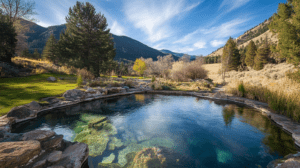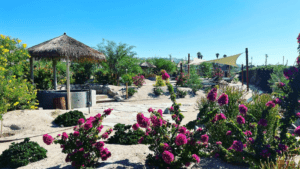Like many others seeking natural ways to enhance well-being, you might find the health benefits of hot springs particularly appealing. These natural pools not only provide a serene escape but also offer therapeutic advantages, such as improved blood circulation, muscle relaxation, and enhanced skin health.
However, it’s important to be aware of the risks involved, including high temperatures and potential bacterial infections. This guide will explore how to safely enjoy hot springs and highlight effective hydrotherapy practices to ensure you reap all the benefits while minimizing any risks.
Key Takeaways:
- Hot springs are natural sources of mineral-rich water that provide numerous health benefits, such as relieving muscle pain and stiffness, promoting relaxation and stress relief, and improving blood circulation while also aiding in detoxification and boosting immune function.
- While hot springs can offer many benefits, there are also potential risks to be aware of, including high temperatures, bacterial infections, and chemical exposure.
- To safely enjoy hot springs, it is important to follow precautions such as not staying in the water for too long, avoiding open wounds, and choosing reputable hot springs with proper maintenance and sanitation protocols.
What Are the Health Benefits of Hot Springs?
Hot springs, renowned for their healing properties, have been celebrated throughout history for their significant health benefits, encompassing a wide range of therapeutic effects.
The mineral-rich waters found in natural hot springs, such as those at Iron Mountain Hot Springs and Glenwood Hot Springs Resort in the United States, provide essential minerals like magnesium, sulfur, calcium, and zinc that promote holistic wellness and assist in mineral absorption.
These geothermal waters can help alleviate symptoms of chronic pain, improve blood circulation, enhance relaxation, and support detoxification, making them a valuable wellness practice for those seeking the tranquil environment that hot springs offer.
If you’re intrigued by the particular benefits of sulfur, check our detailed guide on the health benefits of sulfur hot springs here, to learn more about how this mineral can further enhance your wellness experience.
Relieves Muscle Pain and Stiffness
One of the primary health benefits of hot springs is their ability to relieve muscle pain and stiffness through the therapeutic movement and buoyancy effects experienced while bathing.
When immersed in warm water, the body benefits greatly from enhanced muscle relaxation, which helps to alleviate tension and soothe discomfort. This warmth not only promotes a sense of relaxation but also encourages increased blood circulation, optimizing nutrient delivery throughout the body.
The gentle buoyancy of the water significantly reduces strain on the joints, allowing individuals, particularly those suffering from conditions like arthritis, to enjoy movement more freely without the usual restrictions.
Soaking in mineral-rich hot springs can potentially lead to greater mineral absorption, which aids in pain relief, diminishes inflammation, and helps with chronic inflammatory conditions. Many people experiencing arthritis symptoms find that regular visits to these natural therapeutic waters provide respite from flare-ups and chronic pain.
- Warm water promotes muscle relaxation.
- Enhanced blood circulation contributes to pain relief.
- Buoyancy decreases joint stress.
- Mineral absorption supports overall well-being.
Promotes Relaxation and Stress Relief
Hot springs are a sanctuary for promoting relaxation and stress relief, offering a tranquil environment that nurtures mental relaxation and emotional well-being, enhancing the overall tranquility environment.
The soothing warmth of the water, combined with the gentle sounds of nature, creates an ideal setting for individuals seeking respite from their daily stresses, fostering a deeper connection with the nature surrounding them.
This serene backdrop not only encourages deep relaxation but also enhances mindfulness, allowing visitors to immerse themselves fully in the moment.
The psychological benefits are profound; many find themselves experiencing a sense of peace that can alleviate anxiety and foster better emotional regulation.
- The thermal waters are believed to have healing properties that may support mental clarity.
- Engaging in this self-care ritual can lead to improved sleep patterns.
- Socializing in such environments can strengthen relationships, adding another layer of emotional support.
Ultimately, the experience of soaking in hot springs transcends mere physical benefits, serving as a powerful tool for enhancing overall mental health.
Improves Blood Circulation
Soaking in hot springs has been shown to enhance blood circulation, a crucial element for cardiovascular health and overall wellness, which can yield numerous benefits not only for the heart but also for muscles, joints, and even the skin.
This increase in blood flow helps transport essential nutrients and oxygen throughout the body, supporting various physiological processes necessary for maintaining optimum health and contributing to improved cardiovascular health.
The warmth of the water aids in relaxation, which can further improve circulation by dilating blood vessels, allowing for more effective distribution of vital elements to areas that may be suffering due to conditions like arthritis.
The physiological processes behind this phenomenon involve several key factors:
- Enhanced Blood Flow: As the body is immersed in warm water, the heat causes blood vessels to expand, promoting increased flow. This improved circulation can significantly reduce stiffness and pain.
- Thermal Regulation: Hot springs assist in maintaining body temperature, which is particularly beneficial for individuals with chronic conditions. Maintaining an optimal temperature can alleviate muscle tension, further contributing to pain relief.
- Soothing Effect: The buoyancy of hot spring water relieves pressure on joints, especially for those affected by arthritis, allowing for increased mobility and comfort.
By embracing these therapeutic qualities, individuals can experience not just temporary relief but also long-term benefits that can improve their quality of life.
Helps with Skin Conditions
The mineral-rich waters of hot springs are exceptionally beneficial for addressing various skin issues, providing a natural remedy for conditions such as eczema, psoriasis, and dermatitis.
These therapeutic waters are infused with a diverse array of minerals, notably sulfur and zinc, each playing a vital role in promoting dermatological health.
Sulfur, known for its detoxifying properties, helps to cleanse the skin, reducing inflammation and accelerating the healing process. Meanwhile, zinc contributes significantly to nutrient absorption, facilitating the effective regeneration of skin cells and ensuring that essential nutrients reach the outer layers of the skin.
Together, these minerals not only alleviate existing conditions but also strengthen the skin’s overall resilience against future issues.
- Detoxification: Sulfur helps eliminate toxins.
- Nutrient Absorption: Zinc ensures efficient nutrient delivery.
- Inflammation Reduction: Both minerals work together to soothe irritated skin.
By drawing on the natural healing properties sourced from hot springs, individuals may find a holistic approach to enhancing their skin health, embracing a more vibrant and balanced complexion.
Boosts Immune System
Regular exposure to the healing properties of hot springs can significantly boost the immune system, helping the body combat chronic inflammatory conditions and enhance overall wellness through various mechanisms, including detoxification.
The minerals found in these natural wonders, such as magnesium, calcium, and sulfur, play a vital role in enhancing immune function and supporting overall dermatological health. This enhancement occurs through several pathways, including reducing oxidative stress and improving circulation.
A notable study conducted in Japan in 2012 demonstrated that participants who regularly immersed themselves in mineral-rich hot springs exhibited a marked decrease in inflammatory markers in their blood.
These findings align with the broader understanding that mineral elements such as sodium, lithium, and zinc are critical for cellular processes involved in immune health and contribute to skin issues like eczema and psoriasis.
- Magnesium helps regulate inflammatory responses.
- Calcium supports cell signaling, which is crucial for immune reactions.
- Sulfur assists in detoxifying the body.
Consequently, engaging with hot springs doesn’t just provide relaxation; it may also serve as a natural remedy for bolstering the body’s defenses against chronic inflammation.
What Are the Potential Risks of Hot Springs?
While hot springs offer numerous health benefits, including pain relief and relaxation benefits, it is essential to be aware of the potential risks involved, which include high temperatures, bacterial infections, and chemical exposure that could affect skin health.
High Temperatures
Hot springs can reach extremely high temperatures, posing a risk of dehydration and heat-related illnesses for bathers, especially if they are not mindful of their time spent in the water and do not regularly check the temperature.
To ensure a safe and enjoyable experience, it’s essential to monitor water temperature consistently and limit soak time to prevent dehydration and ensure optimal thermal regulation. A few recommendations include:
- Always test the temperature with a reliable thermometer before entering.
- Limit your soak to 15-20 minutes at a time to prevent overheating.
- Take breaks and hydrate frequently with water or electrolytes to replenish lost fluids.
- Be aware of your body’s signals—if you start feeling dizzy or uncomfortable, exit the water immediately.
By adhering to these safety tips, bathers can enjoy the therapeutic benefits of hot springs while minimizing health risks associated with excessive heat exposure.
Bacterial Infections
{ Another risk associated with hot springs is the potential for bacterial infections, which can impact your overall health and well-being if proper hygiene practices are not followed., particularly affecting skin health if proper hygiene practices are not followed.
These warm, nutrient-rich environments can foster the growth of various bacteria, including *Legionella*, *Pseudomonas aeruginosa*, and *Naegleria fowleri*. When bathers immerse themselves without precautions, they may introduce these organisms into open wounds or mucous membranes, leading to a range of unsettling symptoms such as rashes, skin irritations, or, in more severe cases, respiratory issues.
To minimize the chances of infection, bathers should adhere to the following preventive measures:
- Shower before entering the hot spring to remove any potentially harmful bacteria from the skin.
- Avoid touching the face and eyes with wet hands, especially if skin integrity is compromised.
- Stay hydrated and avoid prolonged exposure to the water.
- Cover any cuts or abrasions with waterproof bandages.
By implementing these practices, individuals can significantly decrease the likelihood of encountering a bacterial infection during their hot spring experience.
” }html
Another risk associated with hot springs is the potential for bacterial infections, particularly affecting skin health, if proper hygiene practices are not followed. These warm, nutrient-rich environments can foster the growth of various bacteria, including *Legionella*, *Pseudomonas aeruginosa*, and *Naegleria fowleri*.
When bathers immerse themselves without precautions, they may introduce these organisms into open wounds or mucous membranes, leading to a range of unsettling symptoms such as rashes, skin irritations, or, in more severe cases, respiratory issues.
To minimize the chances of infection, bathers should adhere to the following preventive measures:
- Shower before entering the hot spring to remove any potentially harmful bacteria from the skin.
- Avoid touching the face and eyes with wet hands, especially if skin integrity is compromised.
- Stay hydrated and avoid prolonged exposure to the water.
- Cover any cuts or abrasions with waterproof bandages.
By implementing these practices, individuals can significantly decrease the likelihood of encountering a bacterial infection during their hot spring experience.
Chemical Exposure
Bathing in certain hot springs may expose individuals to harmful chemicals due to the mineral content and water quality.
Bathers must understand the potential risks associated with various mineral springs. Factors such as chemical exposure can play a significant role in health outcomes, especially when considering contaminants like arsenic, lead, and other heavy metals that can be found in some natural waters. To ensure a safe and enjoyable experience, individuals should:
- Research the hot spring’s local regulations and safety reports.
- Consult reviews that highlight water quality and potential hazards.
- Consider the spring’s mineral composition to ensure it aligns with personal health needs.
By being informed and cautious, one can thoroughly enjoy the therapeutic benefits of hot springs while minimizing exposure to harmful chemicals.





